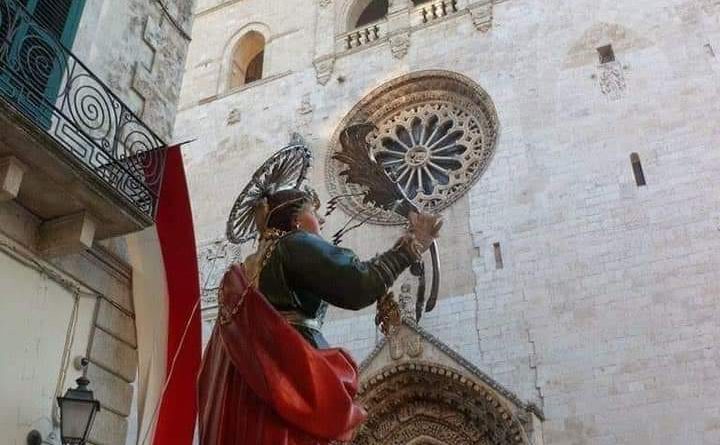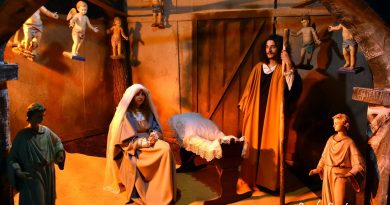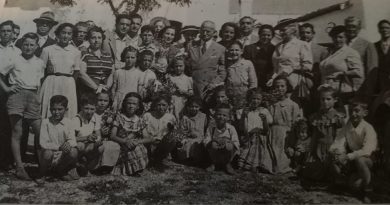Chi era Sant’Irene e perché è patrona di Altamura?
Un tuffo nella storia della santa protettrice della città di Altamura.
Irene, che a Lecce è chiamata Erina, era figlia di un signorotto di nome Licinius, che geloso della bellezza della figlioletta, all’età di sei anni la rinchiuse sulla cima di una torre, sorvegliata da tredici servi.
Dio la istruì nel cuor suo della dottrina cristiana e s. Timoteo, discepolo di s. Paolo, la battezzò. Lei prese gli idoli che il padre le aveva dato da adorare e li infranse; il padre preso dall’ira la fece legare su un cavallo imbizzarrito per farla morire, ma miracolosamente Irene si salvò, mentre il padre morì a causa delle conseguenze di un morso ricevuto alla mano, dallo stesso cavallo.
La giovane cristiana ottenne con le preghiere, la resurrezione del padre, il quale unitamente alla famiglia ed a circa tremila pagani, si convertì al cristianesimo. Il governatore Ampelio tentò di farla apostatare e al suo rifiuto, inferocito, la fece torturare e decapitare. (In questa ‘Vita’ non vi è alcuna indicazione di luogo né di data).
Altre ‘Vite’ che sono lo svolgimento e l’abbellimento della precedente, sono condensate nei sinassari bizantini, uno di questi, narra che Irene nacque a Magedo (Persia) figlia di re e prima di essere battezzata si chiamava Penelope, segue tutta una carrellata d’inverosimili miracoli e conversioni di pagani in massa; alla fine la santa è mandata a morte dal re di Persia, Sapore (272), al tempo di Costantino imperatore.
Secondo un’altra tradizione Irene, figlia di Licinio, sarebbe originaria di Lecce, dove è festeggiata al 5 maggio con il nome di Erina.
Dal V secolo a Costantinopoli vi erano già due chiese a lei intitolate, più volte restaurate e ricostruite di cui una esiste tuttora.
Il nome Irene deriva dal greco Eiréne e vuol dire Pace, infatti la dea della pace, nella mitologia greca, si chiamava appunto Irene; il nome venne adottato nel latino imperiale con significato augurale e poi dai cristiani come nome apportatore di pace tra tutti i fratelli in Cristo e soprattutto della Pace celeste. *
Sant’Irene diventa patrona ‘minore’ di Altamura nel 1728 allorché la popolazione altamurana fece pressione sul clero prechè venisse esaurita questa richiesta. Ma perchè gli altamurani volevano così fortemente Sant’Irene come protettrice della città? I motivi sono raccontati nel libro “ALTAMURA – Storia, Arte, Folklore, Gastronomia”: “La città subiva la caduta di molti fulmini che colpivano persone, greggi, case e chiese. In particolare, l’anno prima, proprio la Cattedrale era stata colpita da due fulmini caduti direttamente sull’altar maggiore e nel coro. S. Irene, già patrona di Lecce, era protettrice di questo flagello, tanto da venir invocata con questa giaculatoria in dialetto:
“Sanda Rèna benedetta,
sobb au monde fu costretta;
durnaje e lambesciaje e
Sanda Rèna ne reparaje.”
Sicchè la concessione ecclesiastica del patronato a questa Santa fu accolta con gioia e fervore dal popolo, tanto che, dopo due secoli (1937) anche il Vaticano dovette promuoverla a ‘patrona principale’, dopo aver già concesso lo spostamento della sua festa dal 5 maggio al 16 agosto.”
Oggi però viene celebrata il 5 di maggio.
Who was Saint Irene and why is she the patron saint of Altamura ?
A dip in the history of the patron saint of the city of Altamura.
Irene, who is called in Lecce Erina , was the daughter of a gentleman by the name of Licinius , who, being jealous of the beauty of his daughter , locked her up on top of a tower, guarded by thirteen servants when she was just six years old.
God instructed her in her heart of the Christian doctrine and was baptized by S. Timothy , a disciple of s. Paul, so she took the idols that her father had given her to worship and broke them up ; her father,taken by anger, had her tied to a wild horse to make her die, but miraculously Irene survived , while her father died of the consequences of receiving a bite to his hand from the same horse.
The young Christian won through prayers the resurrection of her father, who, together with his family and about three thousand pagans, converted himself to Christianity . The governor Ampelio tried to have her apostatize and due to her rejection he got enraged and had her tortured and beheaded. (In this legend about Irene’s life there is no indication of place or date ) .
Other “Tales “ that served as embellishment of the previous one, are condensed in Byzantines sinassari and one of them tells that Irene was born in Magedo ( Persia) and she, as the daughter of the king and before being baptized, was called Penelope , then it follows a whole roundup of improbable miracles and conversions of many pagans; in the end the Saint was sent to death by the king of Persia, named Sapore (272) , at the time of Emperor Constantine .
According to another tradition Irene , daughter of Licinius , would allegedly be originally from Lecce , where her festivity is celebrated on May 5, with the name of Erina .
From the fifth century there were already two churches named after her in Constantinople , restored and rebuilt several times , one of which still exists .
The name Irene derives from the Greek and means Peace, in fact, the goddess of peace, in Greek mythology, was called Irene ; the name was adopted in the imperial Latin with an augural meaning and then by Christians as the name bearer of peace among all brothers in Christ and especially of Heavenly Peace . *
Irene becomes ‘ minor ‘ patron of Altamura in the 1728m when the population put pressure on the clergy so that their request was accepted. But did Altamura people wanted so strongly Irene to be the protector of their city? The reasons are told by Bianca Tragni in her book ” ALTAMURA – History, Art, Folklore , Gastronomy “: “
The town was suffering the fall of lightning that struck many people , flocks , houses and churches. In particular , the year before , the cathedral itself had been hit by two lightning strikes directly on the high altar and on the choir . St. Irene, already the patron saint of Lecce , became the patron of this scourge , so as to be relied on with this short prayer in the local dialect :
” Blessed S. Irene,
on a mount was forced to be,
as it thundered and struck lightning,
S. Irene protected.us”
And so the granting of ecclesiastical patronage to this Saint was greeted with joy and fervor by the people , so that, after two centuries (1937) also the Vatican had to promote her to ‘ principal patroness ‘ , having already given the shift of her celebration from May 5 August 16 . “
Today, however, it is celebrated on the 5th of May
Foto di Massimo Colonna



